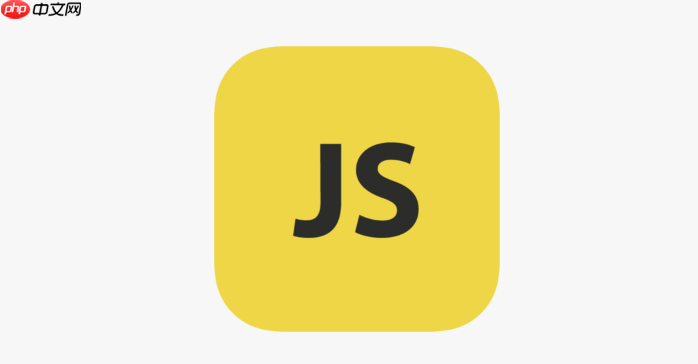javascript的bind方法用于改变函数内部this的指向并可预先设置参数。1. 它通过绑定thisarg指定函数运行时的this值;2. 可传入arg1、arg2等参数作为函数调用时的预设实参;3. 能解决this指向不明确的问题,如在settimeout中固定this;4. 与箭头函数不同,bind可动态改变this,而箭头函数的this在定义时已固定;5. 可用于函数柯里化,通过固定部分参数生成新函数;6. 需注意性能问题,频繁使用会增加内存消耗;7. 在react中常用于绑定事件处理函数的this指向,也可被箭头函数替代。

JavaScript的bind方法,简单来说,就是改变函数内部this的指向,并且可以预先设置函数的部分参数。它就像一个“胶水”,把函数和对象粘在一起,让函数知道它应该在哪个对象的作用域下运行。

bind方法主要用于解决JavaScript中this指向不明确或者需要固定this指向的问题。它能够创建一个新的函数,当被调用时,其this关键字会被设置为提供的值,并在调用新函数时,预先传入指定的参数序列。
bind 方法的基本用法bind方法是定义在Function原型上的,所以所有的函数都可以调用它。其基本语法如下:
立即学习“Java免费学习笔记(深入)”;

function.bind(thisArg[, arg1[, arg2[, ...]]])
thisArg: 当绑定函数被调用时,该参数会作为this传递给目标函数。如果使用new运算符构造绑定函数,则忽略该参数。arg1, arg2, ...: 当绑定函数被调用时,这些参数将作为实参传递给目标函数。举个例子:
const person = {
name: 'Alice',
greet: function(greeting) {
console.log(greeting + ', my name is ' + this.name);
}
};
const greetAlice = person.greet.bind(person, 'Hello');
greetAlice(); // 输出: Hello, my name is Alice
const anotherPerson = { name: 'Bob' };
const greetBob = person.greet.bind(anotherPerson, 'Hi');
greetBob(); // 输出: Hi, my name is Bob在这个例子中,bind方法将person对象的greet方法绑定到了person对象本身,并预先传入了'Hello'参数。 之后,又将greet方法绑定到了anotherPerson对象,并预先传入了'Hi'参数。

bind 方法解决 this 指向问题在JavaScript中,this的指向是一个比较让人头疼的问题。它取决于函数是如何被调用的,而不是函数在哪里被定义的。 比如,在事件处理函数中,this通常指向触发事件的元素;在定时器函数中,this通常指向全局对象(在浏览器中是window,在Node.js中是global)。
bind方法可以用来固定this的指向,避免出现意外的错误。
function MyComponent() {
this.name = 'MyComponent';
setTimeout(function() {
console.log(this.name); // 输出: undefined (在浏览器中) 或 '' (在Node.js中)
}, 1000);
}
new MyComponent();上面的代码中,setTimeout中的this指向了全局对象,而不是MyComponent的实例。 使用bind方法可以解决这个问题:
function MyComponent() {
this.name = 'MyComponent';
setTimeout(function() {
console.log(this.name); // 输出: MyComponent
}.bind(this), 1000);
}
new MyComponent();通过bind(this),我们将setTimeout中的函数的this绑定到了MyComponent的实例上,从而解决了this指向的问题。
bind 方法与箭头函数的区别
箭头函数也有改变this指向的功能,但它与bind方法有所不同。箭头函数会捕获其所在上下文的this值,并且这个this值是不可变的。 也就是说,箭头函数的this指向在定义的时候就已经确定了,而bind方法则可以在函数调用的时候动态地改变this的指向。
const person = {
name: 'Alice',
greet: () => {
console.log(this.name); // 输出: undefined (取决于定义时所在上下文的this)
}
};
person.greet();
const anotherPerson = { name: 'Bob' };
const greetBob = person.greet.bind(anotherPerson);
greetBob(); // 输出: undefined (箭头函数的this无法被bind改变)在这个例子中,即使使用bind方法将greet函数的this绑定到anotherPerson对象,箭头函数中的this仍然指向定义时所在上下文的this,无法被改变。
bind 方法进行函数柯里化?函数柯里化是一种将使用多个参数的一个函数转换成一系列使用一个参数的函数的技术。bind 方法可以用来实现函数柯里化。
function multiply(a, b) {
return a * b;
}
const multiplyByTwo = multiply.bind(null, 2);
const multiplyByThree = multiply.bind(null, 3);
console.log(multiplyByTwo(5)); // 输出: 10
console.log(multiplyByThree(5)); // 输出: 15在这个例子中,我们使用 bind 方法创建了两个新的函数 multiplyByTwo 和 multiplyByThree,它们分别将 multiply 函数的第一个参数固定为 2 和 3。 这样,我们就可以通过调用 multiplyByTwo(5) 和 multiplyByThree(5) 来计算 2 5 和 3 5 的结果。
bind 方法的性能考量虽然bind方法非常有用,但是过度使用也会带来一些性能问题。每次调用bind方法都会创建一个新的函数,这会增加内存的消耗。如果在一个循环中频繁调用bind方法,可能会导致性能下降。
因此,在使用bind方法时,应该尽量避免不必要的绑定,并且尽量将绑定操作放在循环之外。 另外,可以考虑使用箭头函数来代替bind方法,因为箭头函数的性能通常比bind方法更好。
bind 方法在 React 中的应用在React中,bind方法经常被用来绑定事件处理函数中的this指向。
class MyComponent extends React.Component {
constructor(props) {
super(props);
this.handleClick = this.handleClick.bind(this); // 绑定this
}
handleClick() {
console.log(this.props.name);
}
render() {
return (
<button onClick={this.handleClick}>Click me</button>
);
}
}在这个例子中,我们在constructor中将handleClick方法的this绑定到了MyComponent的实例上。 这样,在handleClick方法中就可以访问this.props了。
当然,在React中,也可以使用箭头函数来代替bind方法:
class MyComponent extends React.Component {
handleClick = () => {
console.log(this.props.name);
}
render() {
return (
<button onClick={this.handleClick}>Click me</button>
);
}
}使用箭头函数可以使代码更简洁,并且避免了手动绑定this的麻烦。
以上就是JavaScript的bind方法是什么?怎么用?的详细内容,更多请关注php中文网其它相关文章!

每个人都需要一台速度更快、更稳定的 PC。随着时间的推移,垃圾文件、旧注册表数据和不必要的后台进程会占用资源并降低性能。幸运的是,许多工具可以让 Windows 保持平稳运行。

Copyright 2014-2025 https://www.php.cn/ All Rights Reserved | php.cn | 湘ICP备2023035733号